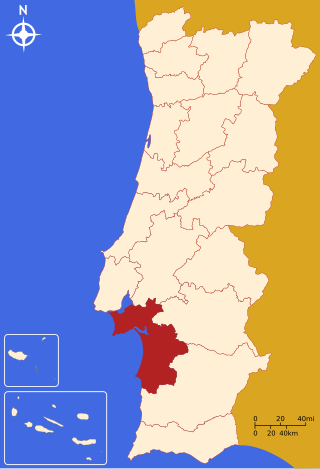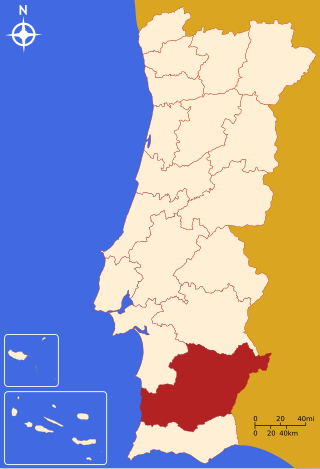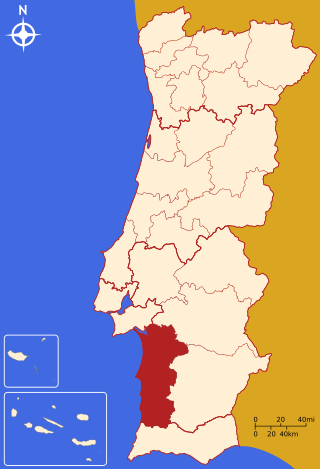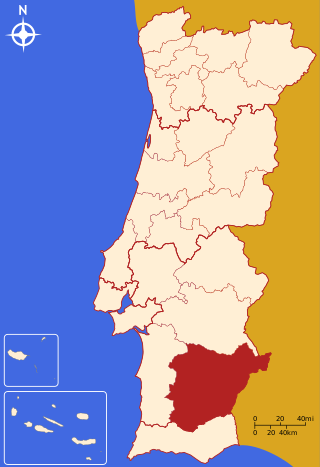
The District of Setúbal is a district located in the south-west of Portugal. It is named for its capital, the city of Setúbal.

The Beja District is located in southern Portugal. The district capital is the city of Beja. It is the largest district of the country by area, and constitutes around 11% of its area.

Évora District is located in Alentejo, in southern Portugal. The district capital is the city of Évora.

The Ribatejo is the most central of the traditional provinces of Portugal, with no coastline or border with Spain. The region is crossed by the Tagus river. The region contains some of the nation's richest agricultural land, and it produces most of the animals used in the Portuguese style of bullfighting.

Alto Trás-os-Montes, or Nordeste Transmontano, is a former NUTS-level 3 subregion of the Norte Region of Portugal. It was abolished at the January 2015 NUTS 3 revision. Its 15 municipalities occupied an area of 8,168 km2 (3,154 sq mi) in the north-east of continental Portugal with an estimated 2008 population of 214,460 inhabitants; thus it constituted approximately 40% of the area, but only 6.1% of the population, of the Norte Region.

The Comunidade Intermunicipal do Alentejo Central is an administrative division in Portugal. It was created in 2009. The seat of the intermunicipal community is Évora, the main city. Other cities are Estremoz, Montemor-o-Novo, Vendas Novas and Reguengos de Monsaraz. Alentejo Central is coterminous with the former Évora District. The population in 2011 was 166,726, in an area of 7,393.46 km2.

The subdivisions of Portugal are based on a complicated administrative structure. The second-level administrative division, after the 5 regions and 2 autonomous regions, is 308 municipalities (concelhos) which are further subdivided into 3091 civil parishes (freguesias).

The Comunidade Intermunicipal do Alentejo Litoral is an administrative division in Portugal. It was created in May 2009. It is also a NUTS3 subregion of the Alentejo Region. The seat of the intermunicipal community is Grândola. Alentejo Litoral comprises municipalities of both the Beja District and the Setúbal District. The population in 2011 was 97,925, in an area of 5,309.41 km2.

The Castle of Terena is a castle in the civil parish of Terena in the municipality of Alandroal in the Portuguese subregion of Alentejo Central. Since 1946, it has been listed as a National monument.

Baixo Alentejo was a Portuguese province. It was abolished with the Constitution of 1976.

The Comunidade Intermunicipal do Alto Alentejo is an administrative division in Portugal. It was created in 2009. The seat of the intermunicipal community is Portalegre. Alto Alentejo is coterminous with the former Portalegre District. The population in 2011 was 118,506, in an area of 6,084.34 km². Together with Alentejo Central it covers the area of the former Alto Alentejo Province. With Ponte de Sor the intermunicipal community also includes one municipality that lies in the area of the former Ribatejo Province.

The Comunidade Intermunicipal do Baixo Alentejo is an administrative division in Portugal. It was created in 2009. It is also a NUTS3 subregion of the Alentejo Region. The seat of the intermunicipal community is Beja. Baixo Alentejo comprises 13 of the 14 municipalities of the Beja District. The population in 2011 was 126,692, in an area of 8,542.72 km².

Queijo de Nisa is a semi-hard sheep's milk cheese from the municipality of Nisa, in the subregion of Alto Alentejo in Portugal. It is created from raw milk, which is coagulated, then curdled using an infusion of thistle. It is yellowish white, with a robust flavor and a somewhat acidic finish.

Alentejo Region is one of the seven NUTS 2 regions of Portugal. It covers all of the historical Alentejo Province and part of the historical Ribatejo and Estremadura provinces.

The intermunicipal community is a type of administrative division in Portugal. Since the 2013 local government reform, there are 21 intermunicipal communities. They replaced the urban communities, the intermunicipal communities for general purposes and some metropolitan areas that were created in 2003, and abolished in 2008. The territories of the intermunicipal communities are the basis of the NUTS III statistical regions.

The Castle of Borba is a medieval castle located in the civil parish of Borba, municipality of Borba, Portuguese district of Evora.
This page is based on this
Wikipedia article Text is available under the
CC BY-SA 4.0 license; additional terms may apply.
Images, videos and audio are available under their respective licenses.
















